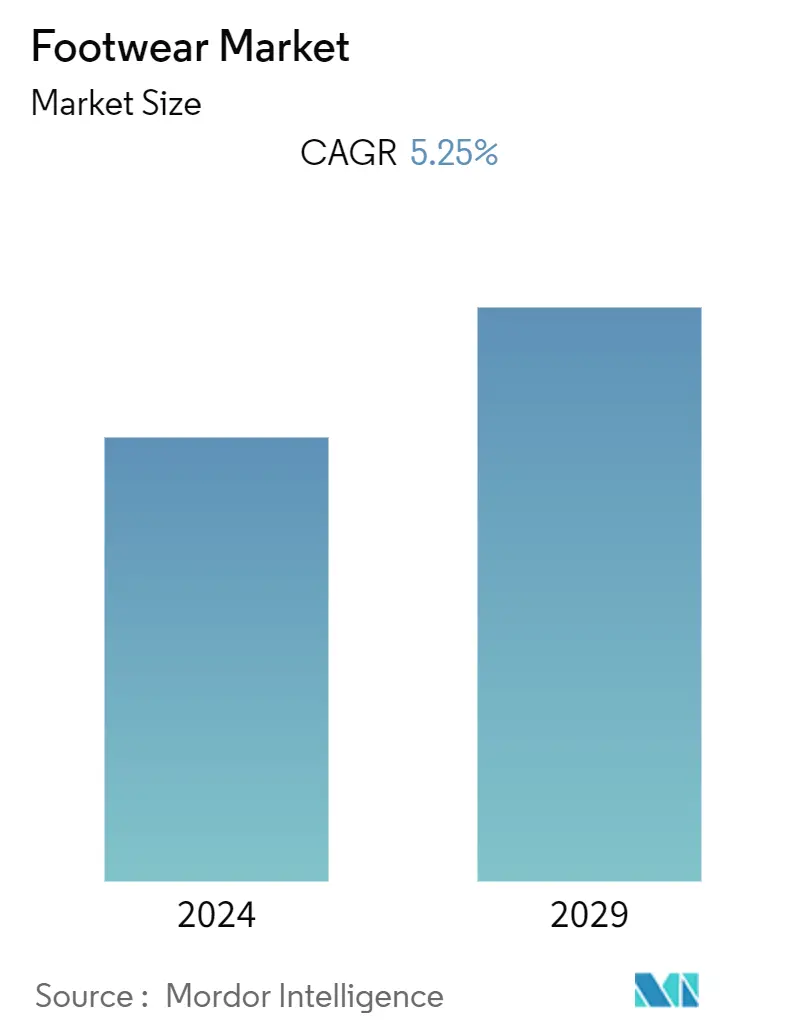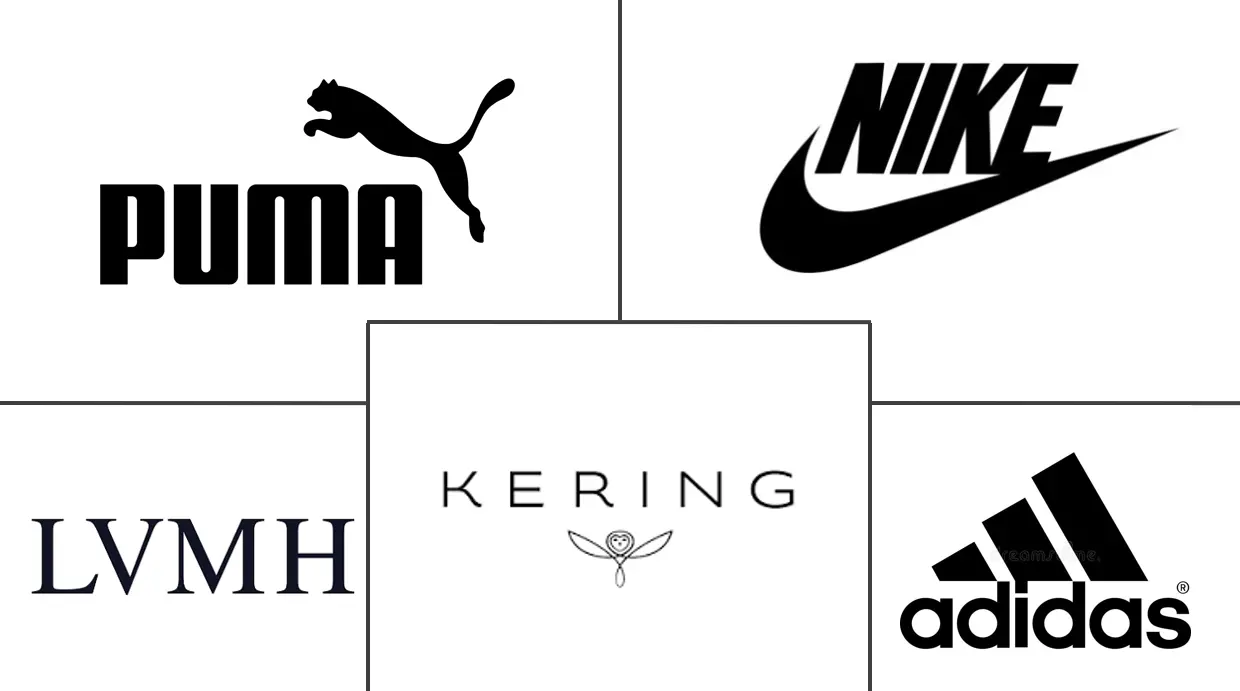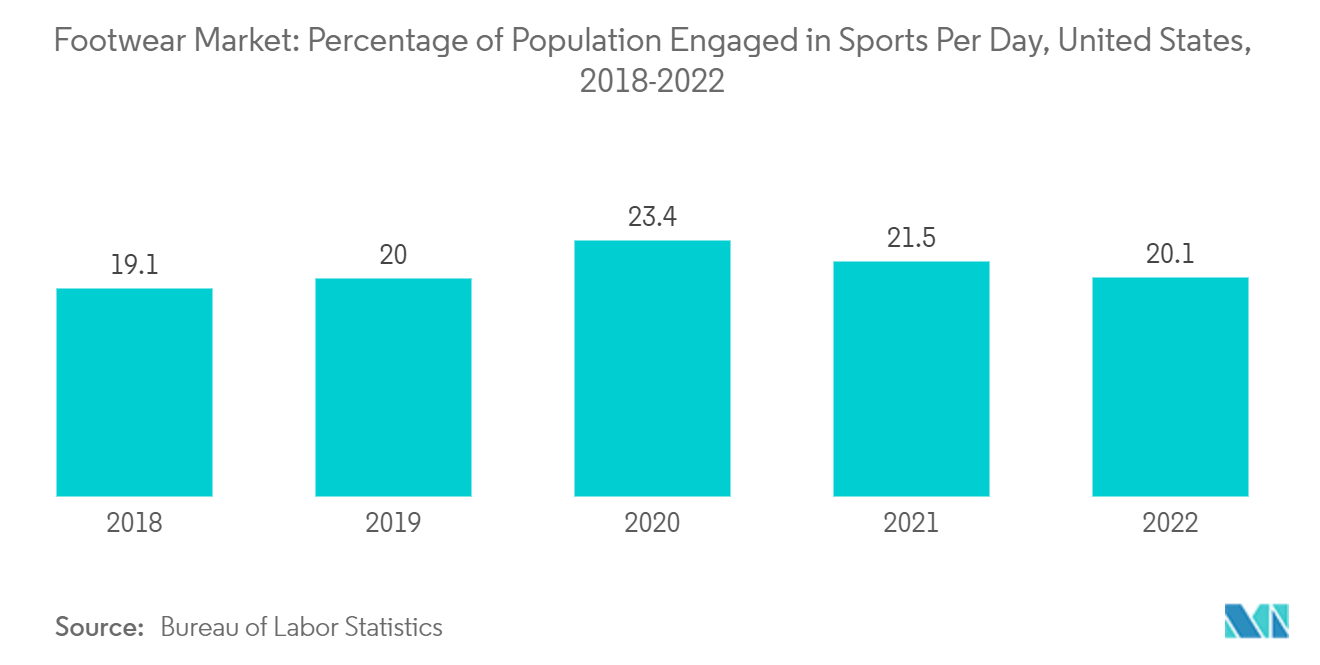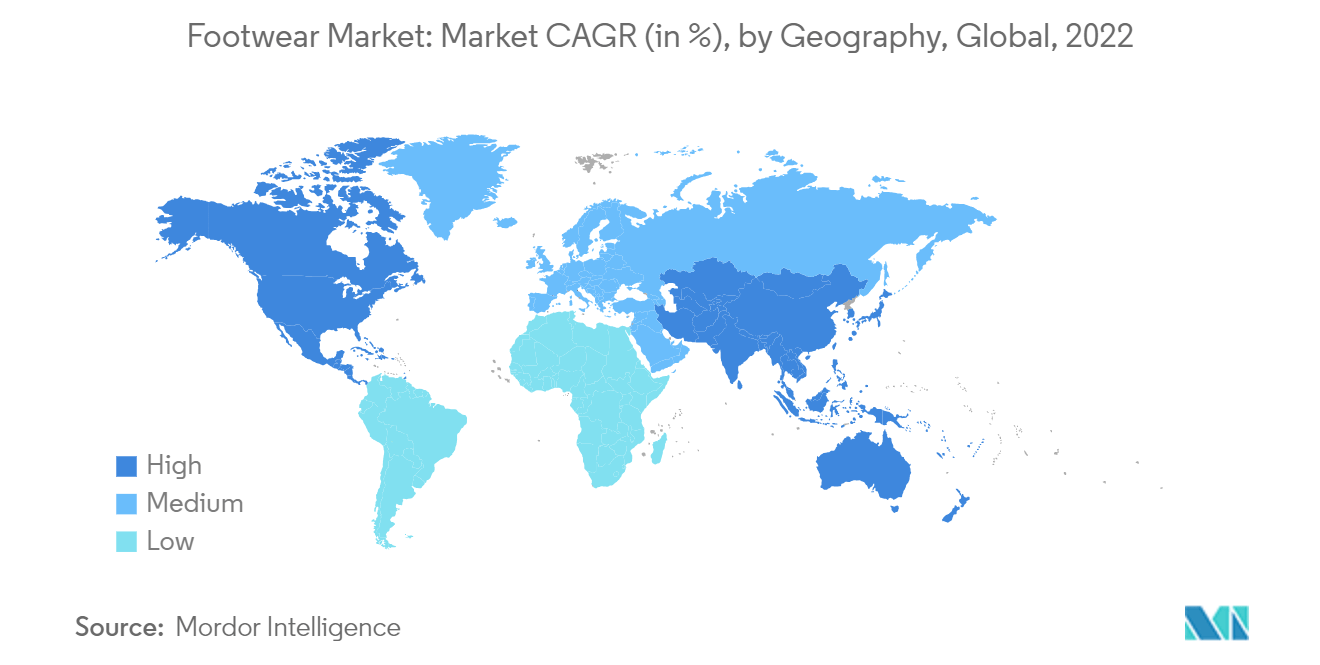Footwear Market Size

| Study Period | 2018 - 2029 |
| Base Year For Estimation | 2023 |
| CAGR (2024 - 2029) | 5.25 % |
| Fastest Growing Market | Europe |
| Largest Market | Asia Pacific |
| Market Concentration | Low |
Major Players
*Disclaimer: Major Players sorted in no particular order |
Footwear Market Analysis
The Footwear Market is expected to register a CAGR of 5.25% during the forecast period.
- The rising demand for fashionable, trendy, yet comfortable footwear across all age groups is a key factor driving the global footwear industry. The rise in the growth of sports-focused footwear, such as football, cricket, basketball, and golf, coupled with exponential investment by governments and global organizations to promote sports leagues and participation, has been a key driver for the market.
- Asian countries, such as China and India, are the major exporters of leather footwear across developed countries. For instance, according to the Department for Promotion of Industry and Internal Trade, it is estimated that about USD 2,047.08 million worth of leather footwear products was exported from India to other parts of the world in 2022.
- Additionally, an emerging trend in the global footwear market is the rise in demand for eco-friendly footwear. There has been a growth in the usage of sustainable materials and sustainable footwear brands that have embedded sustainability into their brands from their beginnings. The manufacturers have been finding innovative ways to manufacture such products to suit customer demands.
- For instance, in August 2022, Solecraft, an indigenous sustainable footwear company in India, announced the launch of its first pair of sweat-resistant charcoal shoes. The company claimed that only natural materials were used in the manufacturing of these eco-friendly sneakers. The company revealed that the product was developed in India and manufactured using Japanese bamboo charcoal, premium Australian Merino wool, and plant-based recycled coffee grounds oil.
- Athleisure has become more pervasive, as it has influenced the athletic footwear choice among millennial parents. Due to this factor, they are dressing their kids in athletic apparel and footwear. This is driving the sales of overall footwear across the world.
- Non-athleisure footwear products such as boots, sandals, and flip-flops are commonly used by the consumer in day-to-day life. Hence, manufacturers in the market are focusing on innovative and user-friendly designs to attract consumers. Moreover, sneakers stand out to be one of the popular types of footwear products across the market owing to the comfort and design of the products. Sneakers were popular among young consumers. They often tend to buy expensive pairs of sneakers as an investment and enthusiasm towards exclusive collections available across the market.
Footwear Market Trends
Potential Increase in Demand for the Athletic Footwear Segment
- Growing enthusiasm and awareness regarding the health benefits of sports and fitness activities, the flourishing retail e-commerce sector worldwide, and rising levels of disposable income of consumers are the key factors facilitating segment growth. Rising health concerns because of a sedentary lifestyle and the resultant problems caused by it are benefitting athletic footwear demand. This influences people to actively take part in both indoor and outdoor physical activities.
- Sports such as soccer, basketball, tennis, badminton, and other physical activities such as running, gymming, and others have become common among consumers. For instance, according to Sports England, it is estimated that about 5,896.8 participated in running, 4,842.6 in gym sessions, and 2,012.3 participated in soccer and other physical activities at least twice a month in England between 2021 and 2022. These sports require a certain amount of physical fitness and minimum equipment, such as shoes that protect feet and give comfort while performing the activity. These factors encourage the customer to buy or own more than one pair of footwear dedicated to the sport, resulting in increasing the sales of the footwear in the market.
- Moreover, major global sporting events held periodically, like the Olympics, Commonwealth Games, Asian Games, Cricket World Cup, Super Bowl, and FIFA World Cup, also boost the demand from both athletes and non-athletes individuals. For example, in March 2022, Puma partnered with Lega Serie A. Puma to be a technical partner of the football league and was the official supplier of athleisure and football for all matches in Europe. The footwear market has seen a steep rise in the demand for athletic footwear emerging from lifestyle users, owing to the growing health consciousness.

Asia-Pacific Holds a Prominent Share in Footwear Industry
- China and India alone account for nearly one-third of the global population, and this ensures that the Asia-Pacific is the largest footwear market in the world. Countries are likely to maintain their lead as combined. They comprise almost 40% of the entire global footwear market. This can be attributed to several factors, like rapid urbanization and a preference to adopt a Western lifestyle and/or brands, especially in the middle class and rich society. The region is also home to many multinational sports equipment companies that are often at the forefront of innovation. They will likely lead the world in developing new footwear that fulfills both the penchant for design and a preference for superior quality.
- According to the Thailand Textile Institute, around USD 2.16 billion worth of leatherwear and footwear products were imported into Thailand in 2022. Thailand's imports of leather clothing and footwear grew in value that year compared to the year before. According to World Footwear, Asia alone accounted for approximately 87.4% of the world's footwear production in 2022, reflecting the region's significant concentration of the footwear manufacturing industry. This was due to the availability of cheap labor and raw materials, which allowed the manufacturers to produce the footwear at lower prices in bulk amounts. This has led to the availability of numerous options in the footwear category at competitive prices, which drives the market studied across the region.
- Moreover, the footwear industry in Asia-Pacific has been gaining traction in recent years, given people's awareness and consciousness about health and ongoing fashion trends. This has led to a slew of new players, most of whom bank on affordable price points to dive into the masses, mostly in smaller cities and towns. These brands buttress online retailers like Amazon, Flipkart, Rakuten, Foot Locker, and Myntra to penetrate the Asia-Pacific market.

Footwear Industry Overview
The global athletic footwear market is highly competitive, with major market share held by prominent players, such as Puma SE, Nike Inc., Adidas AG, LVHM, Keringa SA, and Puma SE. This is attributable to its higher market penetration, reflecting a strong industry grip through its brands, products, partnerships, and advertising. These progressive brands have laid their hand on every possible strategy to cater to the footwear market's demand, which includes employing aggressive digital campaigns, offering a wide range of innovative and customizable products, including sustainable footwear, unique and gender-neutral designs that cater to the preferences of all age groups, including athletic shoes specifically designed for kids, and brand collaborations.
Footwear Market Leaders
-
Nike Inc.
-
Adidas AG
-
LVMH Moët Hennessy Louis Vuitton SE
-
Kering SA
-
Puma SE
*Disclaimer: Major Players sorted in no particular order

Footwear Market News
- September 2023: Puma SA unveiled an exciting collaboration with the renowned pop sensation Rihanna, marking the launch of their latest collection of athletic footwear and sportswear under the exclusive Fenty * Puma product line. The standout piece within this collection is a football-inspired shoe, drawing inspiration from the avant-garde, boasting a distinct football trend design, and crafted from sumptuously soft vintage leather.
- September 2023: Nike Inc. introduced their highly-anticipated basketball shoe collection, Luka 2. These cutting-edge products are constructed with a full-length Formula 23 foam for exceptional cushioning and feature an innovative Isoplate foot frame for added support. What sets these shoes apart is their eco-conscious manufacturing process, with 20% of the materials used being recycled, showcasing Nike's commitment to sustainability.
- September 2022: Asics Corporation introduced the Novablast 3, an innovative addition to their footwear lineup. These shoes are characterized by a striking geometric Origami design infused with Asics' cutting-edge technology, delivering a unique cushioning experience that promises a responsive and energetic running adventure.
Footwear Market Report - Table of Contents
1. INTRODUCTION
- 1.1 Study Assumptions and Market Definition
- 1.2 Scope of the Study
2. RESEARCH METHODOLOGY
3. EXECUTIVE SUMMARY
4. MARKET DYNAMICS
-
4.1 Market Drivers
- 4.1.1 Surging Demand for Athleisure Footwear
- 4.1.2 Aggressive Marketing by Brands
-
4.2 Market Restraints
- 4.2.1 Extensive Availability of Counterfeit Products
-
4.3 Porter's Five Forces Analysis
- 4.3.1 Threat of New Entrants
- 4.3.2 Bargaining Power of Buyers/Consumers
- 4.3.3 Bargaining Power of Suppliers
- 4.3.4 Threat of Substitute Products
- 4.3.5 Intensity of Competitive Rivalry
5. MARKET SEGMENTATION
-
5.1 Type
- 5.1.1 Athletic Footwear
- 5.1.1.1 Running Shoes
- 5.1.1.2 Sports Shoes
- 5.1.1.3 Trekking/Hiking Shoes
- 5.1.1.4 Other Athletic Footwear Types
- 5.1.2 Non-athletic Footwear
- 5.1.2.1 Boots
- 5.1.2.2 Flip-Flops/Slippers
- 5.1.2.3 Sneakers
- 5.1.2.4 Other Non-athletic Footwear
-
5.2 End-User
- 5.2.1 Men
- 5.2.2 Women
- 5.2.3 Kids
-
5.3 Distribution Channel
- 5.3.1 Offline Retail Stores
- 5.3.2 Online Retail Stores
-
5.4 Geography
- 5.4.1 North America
- 5.4.1.1 United States
- 5.4.1.2 Canada
- 5.4.1.3 Mexico
- 5.4.1.4 Rest of North America
- 5.4.2 Europe
- 5.4.2.1 Germany
- 5.4.2.2 United Kingdom
- 5.4.2.3 France
- 5.4.2.4 Russia
- 5.4.2.5 Spain
- 5.4.2.6 Italy
- 5.4.2.7 Rest of Europe
- 5.4.3 Asia-Pacific
- 5.4.3.1 China
- 5.4.3.2 Japan
- 5.4.3.3 India
- 5.4.3.4 Australia
- 5.4.3.5 Rest of Asia-Pacific
- 5.4.4 South America
- 5.4.4.1 Brazil
- 5.4.4.2 Colombia
- 5.4.4.3 Rest of South America
- 5.4.5 Middle East & Africa
- 5.4.5.1 South Africa
- 5.4.5.2 Saudi Arabia
- 5.4.5.3 Rest of Middle East & Africa
6. COMPETITIVE LANDSCAPE
- 6.1 Strategies Adopted by Leading Players
- 6.2 Market Share Analysis
-
6.3 Company Profiles
- 6.3.1 Nike Inc.
- 6.3.2 Adidas AG
- 6.3.3 New Balance Athletics, Inc.
- 6.3.4 Asics Corporation.
- 6.3.5 LVMH Moët Hennessy Louis Vuitton SE
- 6.3.6 Fila Holdings Corp.
- 6.3.7 The Bata Corporation
- 6.3.8 VF Corporation
- 6.3.9 Puma SE
- 6.3.10 Under Armour
- 6.3.11 Kering SA
- *List Not Exhaustive
7. MARKET OPPORTUNITIES AND FUTURE TRENDS
** Subject To AvailablityFootwear Industry Segmentation
Footwear is a protective covering for feet, such as shoes, sandals, and other types. These products protect the feet from hurting the feet and help in easing day to day physical activities.
The scope of the global footwear market includes type, end user, distribution channel, and geography. Based on type, the market is segmented under athletic footwear and non-athletic footwear. The athletic footwear segment includes running shoes, sports shoes, trekking/hiking shoes, and other athletic footwear types. The non-athletic footwear segment includes boots, flip-flops/slippers, sneakers, and other non-athletic footwear. Further segmentation is done based on end users, which includes men, women, and kids. The segmentation based on the distribution channel includes offline retail stores and online retail stores. The report outlines the insight of all the global regions, including North America, Europe, Asia-Pacific, South America, and the Middle East & Africa.
The market sizing has been done in value terms in USD for all the abovementioned segments.
| Type | Athletic Footwear | Running Shoes |
| Sports Shoes | ||
| Trekking/Hiking Shoes | ||
| Other Athletic Footwear Types | ||
| Type | Non-athletic Footwear | Boots |
| Flip-Flops/Slippers | ||
| Sneakers | ||
| Other Non-athletic Footwear | ||
| End-User | Men | |
| Women | ||
| Kids | ||
| Distribution Channel | Offline Retail Stores | |
| Online Retail Stores | ||
| Geography | North America | United States |
| Canada | ||
| Mexico | ||
| Rest of North America | ||
| Geography | Europe | Germany |
| United Kingdom | ||
| France | ||
| Russia | ||
| Spain | ||
| Italy | ||
| Rest of Europe | ||
| Geography | Asia-Pacific | China |
| Japan | ||
| India | ||
| Australia | ||
| Rest of Asia-Pacific | ||
| Geography | South America | Brazil |
| Colombia | ||
| Rest of South America | ||
| Geography | Middle East & Africa | South Africa |
| Saudi Arabia | ||
| Rest of Middle East & Africa |
Footwear Market Research FAQs
What is the current Footwear Market size?
The Footwear Market is projected to register a CAGR of 5.25% during the forecast period (2024-2029)
Who are the key players in Footwear Market?
Nike Inc., Adidas AG, LVMH Moët Hennessy Louis Vuitton SE, Kering SA and Puma SE are the major companies operating in the Footwear Market.
Which is the fastest growing region in Footwear Market?
Europe is estimated to grow at the highest CAGR over the forecast period (2024-2029).
Which region has the biggest share in Footwear Market?
In 2024, the Asia Pacific accounts for the largest market share in Footwear Market.
What years does this Footwear Market cover?
The report covers the Footwear Market historical market size for years: 2018, 2019, 2020, 2021, 2022 and 2023. The report also forecasts the Footwear Market size for years: 2024, 2025, 2026, 2027, 2028 and 2029.
Which emerging markets hold potential for footwear export expansion?
Southeast Asia holds potential for footwear export expansion because of the rising disposable incomes and ongoing footwear trends.
Footwear Industry Report
The global footwear market is experiencing significant growth, driven by increased demand for both athletic and non-athletic shoes. This surge in market growth is fueled by a heightened focus on fashion, comfort, and sports participation. The rise in health consciousness and major sports events have particularly boosted the athletic segment, while the non-athletic category sees a preference for eco-friendly and sustainable options. Innovations in shoe production, including the use of natural materials, are reshaping the industry.
Asia-Pacific leads the market due to its vast population and manufacturing hubs. Key market leaders such as Puma SE, Nike Inc., and Adidas AG dominate the industry by leveraging digital campaigns and innovative products that cater to a fashion-conscious and environmentally aware consumer base. According to industry analysis, the market size and industry statistics reveal a promising industry outlook, with a market forecast that points to continuous growth.
The market overview highlights significant trends in both men's, women's, and children's footwear. Market segmentation shows diverse consumer preferences, and market value is driven by the adoption of new materials and designs. Industry reports and market data provide detailed insights into market predictions, industry trends, and industry size.
Industry research and industry information indicate that the market review is positive, with a strong market outlook supported by industry sales and market leaders. The industry reports suggest that the market predictions are favorable, with a consistent growth rate. Research companies provide valuable industry statistics and market data, which are essential for understanding the market value and market segmentation.
Overall, the footwear market is poised for continued expansion, supported by a robust industry outlook and comprehensive industry research. The availability of report examples and report PDFs further aids stakeholders in making informed decisions.



